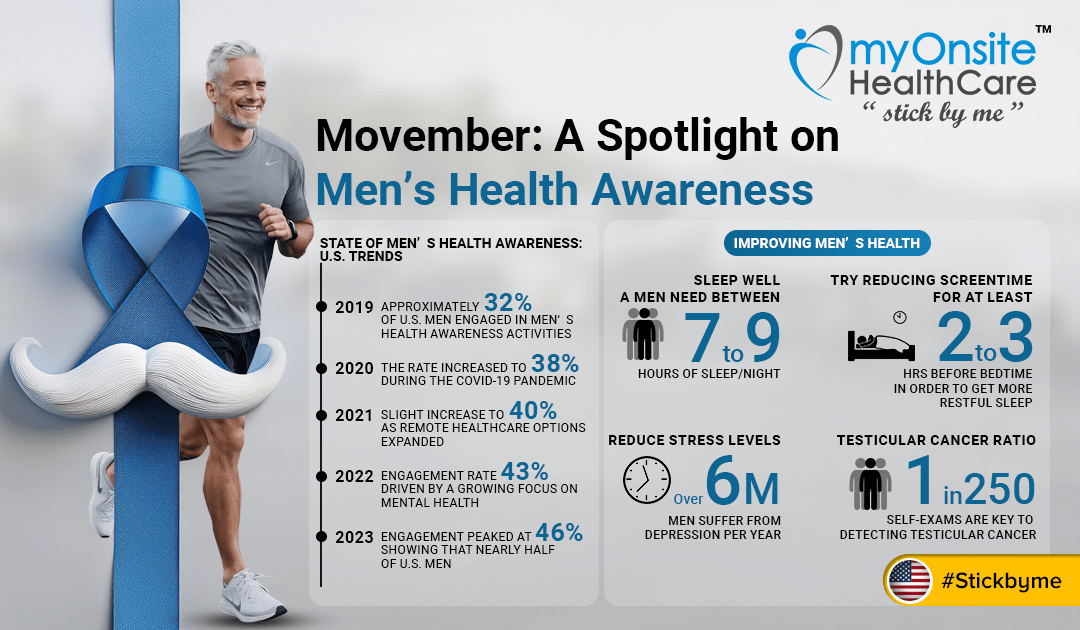Each November, millions of us around the world get together for Movember — an annual month-long event to raise awareness about men’s health issues such as mental health and prostate and testicular cancer. To create where men today are shaving off their whiskers and growing moustaches around the world as a global movement to talk about their health issues. However, men still have some way to go in terms of being aware of or engaging with their health (Movember: 2023). In this post we will discuss some up-to-date statistics, major health problems for men and practical ways to improve men’s health in the United States.
U.S. Trends on Men and Awareness of Their Own Health
Interest in men’s health initiatives has been gradually increasing over the last five years across the United States. Nevertheless, compared to women, men are still less likely to seek help or take part in health awareness events. Now, the awareness and engagement rates for men health over the years are as follows:
- 2019: 32%-ish of U.S. guys are doing men’s health awareness stuff
- 2020: 38%-the COVID-19 pandemic spurred greater health consciousness.
- 2021: One additional percentage point of Engagement (40%) as telehealth opened further.
- 2022: The engagement rate reached 43% due to an increased prioritization of mental health and workplace wellness initiatives.
- 2023: Reaching a record 46% engagement, almost half of U.S. men participated in awareness-raising activities but there is still work to do.
But those improvements are only narrowed toward the low-hanging fruit population not nearly all men benefit from health screenings, mental health care and preventative care.
Top Health Issues of Men
Men have specific health threats that are inadequitely adressed via awareness and treatment. Three main areas affecting men’s health are:
Prostate Cancer
To clarify, prostate cancer is one of the most common cancers to affect men. Statistics from American Cancer Society show that 1 in every 8 men can expect to be diagnosed with prostate cancer during his lifetime, and it is the second leading cause of cancer death amongst American men.
African American men have an even greater risk so they should be screened regularly for prostate cancer if they are over 50.
Testicular Cancer
Testicular cancer is less common but mostly occurs in younger men, especially those aged 15–35. Awareness and self-examinations are imperative for early diagnosis as this type of cancer has a high survival rate when caught in the initial stages.
On Mental Health and Suicide Prevention
Suicide has become increasingly prevalent amongst men — men are three and a half times more likely to take their own lives than women, so the issue of men’s mental health persists. NDI (2021) cites that the stigma of seeking help for mental health issues and a tough-it-out culture greatly affects men from accessing mental health resources.
Major mental health issues in men, such as depression, anxiety and substance abuse occur primarily due to the routine isolation faced by them due to their work stress.
Advancing Men’s Health: What Needs to Happen?
Screening and Check-it up Regularly
- Screening for Prostate—Men over the age of 50, or over the age of 45 for men at greater risk should have prostate exams to identify early signs of cancer.
- Testicular Cancer Self-Exams: Encouraging young men to perform monthly self-exams can help catch things early.
Provide support around mental health and encourage discussions
- Sex education – Talk about mental health openly: Organizations and community leaders can play a critical role in normalising discussions around mental health to reinforce that reaching out for help is a strength and not weakness.
- Make resources available: Providing services such as counseling, hotlines and workplace support programs makes it easier for men to seek help.
Educational and Informational programs
- Scale Up Health Education Programs: This could be the availability of information on men’s health as part of employer, school and community programs for relevant age groups.
- Digital Outreach: Setting social media campaigns and online resources as a way of reaching younger men can provide education about health concerns at different life stages.
Physical Behaviors and Lifestyle Interventions
- Fitness and Diet Plans: Healthy lifestyle modification like remaining bodily energetic and consuming a balanced weight-reduction plan will no longer solely assist in stopping many continual diseases, but additionally enhance well-being overall.
- Preventing Use: Programs to reduce smoking, alcohol, and drug use are among most critical since they lead to many chronic diseases — and mental health problems later in life.
How Movember Transformed the Face of Men’s Health
Since the inception of Movember in 2003, more than $1 billion has been raised to tackle some of the biggest health issues faced by men and engage millions of people in these conversations. That funding has supported more than 1,250 men’s health projects around the globe tackling some of men’s biggest health challenges. Movember initiatives have made a real difference by raising awareness on the issue of men’s health and have proven that change is in fact possible—from research to community based support programs.
Conclusion
This is helping raise awareness of men’s health, but there’s a long way to go before all men feel empowered enough to try and take control of their health. Through continued education, discussions and the availability of resources men can take action in their decision making towards healthier lifestyles. Awareness is only the first step — action creates real change in men’s health, and that definitely goes for Movember.

